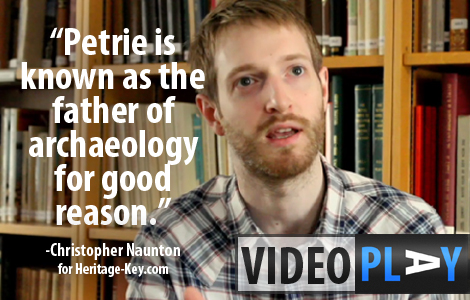 From the bloody rebellion of Boudicca to the fearsome Norman invasion, London had always been under attack in its ancient past. Yet successes during the Middle Ages allowed the city and nation to branch out, conquering new lands and forging trade links all over the world. 1683 saw Oxford play host to the world’s first museum, the Ashmolean, allowing a new generation of explorers to quench their thirst for adventure. And just a few decades later London’s great archaeologists and antiquaries would spread their wings proper, globetrotting to far flung corners of the planet in search of great discoveries and beautiful artefacts.
From the bloody rebellion of Boudicca to the fearsome Norman invasion, London had always been under attack in its ancient past. Yet successes during the Middle Ages allowed the city and nation to branch out, conquering new lands and forging trade links all over the world. 1683 saw Oxford play host to the world’s first museum, the Ashmolean, allowing a new generation of explorers to quench their thirst for adventure. And just a few decades later London’s great archaeologists and antiquaries would spread their wings proper, globetrotting to far flung corners of the planet in search of great discoveries and beautiful artefacts.
That thirst for adventure has rarely weakened, and London is still exploring the ancient world in the form of societies like the Egypt Exploration Society (EES), who have funded some of the world’s greatest discoveries, such as the Tomb of King Tutankhamun (KV62). The discovery of the Tomb of Tutankhamun is another one of these game-changing moments for archaeology,” says EES deputy director Chris Naunton. “It’s absolutely as spectacular an archaeological discovery as you could imagine.
“What was important about the discovery was that it raised public awareness to a new level, Chris adds.
Yet Carter was a mere protege to the ‘Father of Archaeology’, Sir William Matthew Flinders Petrie, a man so highly regarded he had his head preserved after death. He wouldn’t be too impressed, you suspect, that it ended up getting lost in transport between Jerusalem and London, though modern sources suggest it could be safe and sound in London after all. (Petrie’s) legacy is in the methodology he introduces and the rigour he introduces,” says Chris. “He’s known as the father of archaeology for good reason. He really changes the game.”
 Look around cultural epicentres such as the British Museum, and you’ll find a backstory for almost all of their greatest treasures. Take the Elgin Marbles, for instance, taken under dubious circumstances from the Parthenon by Lord Elgin, a British noble, between 1801 and 1812. Taken from Greece while under Ottoman rule the operation cost Elgin around 4 million in modern terms, and the debate rages as to whether they should be returned to Athens alongside the rest of the collection.
Look around cultural epicentres such as the British Museum, and you’ll find a backstory for almost all of their greatest treasures. Take the Elgin Marbles, for instance, taken under dubious circumstances from the Parthenon by Lord Elgin, a British noble, between 1801 and 1812. Taken from Greece while under Ottoman rule the operation cost Elgin around 4 million in modern terms, and the debate rages as to whether they should be returned to Athens alongside the rest of the collection.
The Assyrian Lion Hunt is another spectacular work of art, created for the royal palace of Ashurbanipal at Nineveh between 645 and 635 BC. Metre upon metre of fresco, discovered by the great Sir Austen Henry Layard the hand that rocked the cradle of civilization – shows the ferocity of the king as he slaughters dozens of lions to prove his unrivaled wealth and power.
Yet the greatest of all the Age of Exploration characters must surely be Giovanni Battista Belzoni. An Italian circus strongman who settled in London, Belzoni took a keen interest in ancient Egypt. Soon he’d excavated some of the nation’s most stunning treasures, such as the sarcophagus of Seti I, held today in the Soane Museum. His audacity even stretched to leaving graffiti behind wherever he went including the Pyramid of Khafre at Giza. Belzoni, being a strongman and all-round fixer is perfectly placed to arrange for very large objects, and what we would think of as being fairly prestigious, very important objects, to be moved from where they were found, says Chris. He plays a major part in bringing ancient Egypt, and physically bringing monuments to the west.
These are only a handful of London’s incredible discoveries during the Age of Exploration. Leonard Woolley, for example, unearthed the royal cemeteries of Ur in Mesopotamia, bringing back amazing relics like the Royal Game and Queen’s Lyre. Arthur Evans even found the Palace of Knossos in Crete, the fabled home of the minotaur. People might argue whether Britain’s explorers were fearless globetrotters or carpetbagging looters, but there’s no denying they changed history forever.
HD Video: Episode 11 – Age of Discovery
Click here to view the transcript of this video.
We have many more videos right here at Heritage Key, from the bloody rebellion of Boudicca to an interview with Dr Stephen Quirke at the Petrie Museum – you can even explore Stonehenge for yourself in Stonehenge Virtual. The Ancient World in London is much more than the videos – you can take part in our latest bloggers’ challenge, come along to an event or join the debate on the many issues raised throughout the past three months.